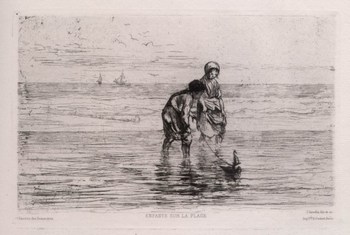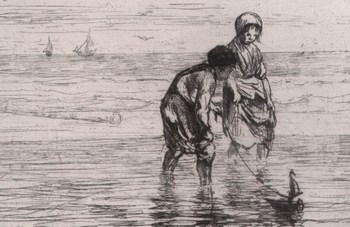|
19thC. French school / Barbizon
Landscapes |
|
Charles-Francois Daubigny
Charles Meyron
Adolphe Appian Maxim
lalanne Henri-Joseph
Harpignies Camille
Corot |
|
|
|
Jozef
IsraŽls (1824-1911)
Jozef IsraŽls was
born into a Jewish family in Groningen. His parents wanted him to be a rabbi and
IsraŽls had to struggle to realise his dream of becoming an artist. The
influences of first Kruseman and then Picot directed him towards the Romantic
tradition of history painting, but although he produced some work in this
tradition (debuting at the Salon de Paris in 1855) he soon abandoned this style,
in favour of the plein-air painting he had encountered at Barbizon in 1846 and
1853, and in Oosterbeek, the Dutch equivalent of Barbizon. From 1855, IsraŽls
made frequent sketching trips to the little fishing village of Zandevoort.
Fishermen became a favourite motif in his art, along with landscapes and scenes
of peasant life.
In 1871 he settled in The Hague, where he remained for the rest of his life. In
his day Jozef IsraŽls enjoyed a huge success, both in Holland and in France. He
remains one of the towering figures of the Hague School; the Dutch equivalent of
Millet. Vincent van Gogh revered IsraŽls and Millet equally, often linking their
names. In a letter of March 1884 he described them, along with Corot, Daubigny
and Duprť, as “the great forerunners”. With IsraŽls’ etchings, we are suddenly
surprised by a lightness of touch that is decidedly Impressionist in its aims
and its techniques, with all the details simply indicated by quick fresh lines
rather than laboriously delineated. IsraŽls became interested in etching in
1870, and produced in all 30 plates, which are described and illustrated in the
catalogue raisonnť by H. J. Hubert, The Etched Work of Jozef IsraŽls. IsraŽls
treated his etchings rather like sketches, printing them in small numbers to
give to friends. They were not usually formally editioned,
Writing of the etchings of IsraŽls in L’Art in 1879, the critic Charles Tardieu
describes them as a painter’s etchings, and deliberately links them to
Impressionism by describing them as “esquisses et impressions”, sketches and
impressions. The confidence and rapidity with which IsraŽls has sketched these
scenes onto the etching plate gives a sense of intimacy and immediacy. There is
also a real tenderness in his depiction of the bathing children and the resting
fisherwoman.
|
A fine scene on the beach

ENFANTS SUR LA PLAGE
APRIL 1879
Reference:
Bťraldi 1, Sanchez & Seydoux 1879-9
Ocasionally IsraŽls allowed art revues such as the Gazette des
Beaux-Arts or L’Art, to print editions of them. This is the source
of this delightful etching, Enfants sur la plage and ņ Scheveningue.
Etching.
Printed by Cadart on laid paper, published by the Gazette des
Beaux-Arts. Artist, title, publisher and printer are credited below
15 by
23 cm on plate border.
Laid paper sheet measures 21 by 28 cm
Price:
340 EURO
|
You can access larger images by clicking on the thumbnails.
Contact me for prices and availability before purchase.
Below you can access detail
images to see the quality of these works.


